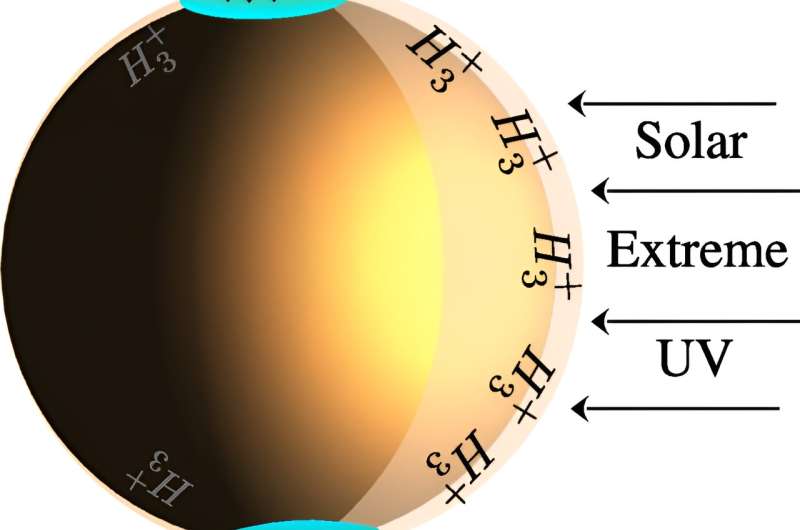
Scheme of H3+ production on Jupiter. Auroral H3+ emission near the magnetic poles originates from precipitating electrons, and extreme solar ultraviolet rays radiate dayside and dominate H3+ production near the equator. No H significant3+ is expected at low latitudes on the night side, making it an ideal DM signal region. Credit: Physical review papers (2024). DOI: 10.1103/PhysRevLett.132.261002
A pair of astrophysicists with Princeton University and the SLAC National Accelerator Laboratory found possible evidence of dark matter particles colliding. In their study, published in Physical review papersCarlos Blanco and Rebecca Leane performed measurements of Jupiter’s equatorial region at night to minimize auroral influences.
Since it was first proposed in the 1930s, dark matter has been at the forefront of physics research, although it has yet to be directly detected. However, most in the field believe it makes up roughly 70% to 80% of all matter in the universe. It is believed to exist because it is the only explanation for the strange gravitational effects observed in the motion of galaxies and the motion of stars.
The researchers hypothesize that it may be possible to detect dark matter indirectly by identifying the heat or light emitted when dark matter particles collide and destroy each other. In this new study, researchers found what they believe may be one such example – light in Jupiter’s outer atmosphere on the dark side.
They suggest that dark matter particles are pulled towards Jupiter by its strong gravity and collide with its ionosphere. As they do so, the researchers reason, there are likely times when they collide and produce light.
To confirm their theory, the researchers studied data captured by Cassini’s visual spectrometer and infrared mapper over a three-hour period. More specifically, they looked at the planet’s nocturnal measurements over its equatorial region. This, they believed, would reduce the impact of Jupiter’s aurora.
Among the data, they were looking for evidence of more H3+ than can be explained by other means, because theories have suggested that it would be produced by dark matter particles after the collision.
The researchers found H3+, but it is still not clear whether the amounts they measured were more than could have been generated by other means; therefore, they plan to continue their work, hoping to find evidence that they were created by dark matter collisions.
More information:
Carlos Blanco et al, The Search for Dark Matter Ionization on Jupiter’s Night Side with Cassini, Physical review papers (2024). DOI: 10.1103/PhysRevLett.132.261002
© 2024 Science X Network
citation: Infrared glow high in Jupiter’s atmosphere may be dark matter particles colliding (2024, July 2) Retrieved July 2, 2024 from https://phys.org/news/2024-07-infrared-high- jupiter-atmosphere-dark.html
This document is subject to copyright. Except for any fair agreement for study or private research purposes, no part may be reproduced without written permission. The content is provided for informational purposes only.